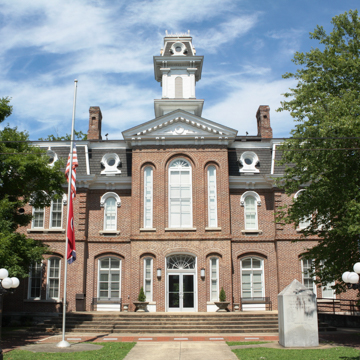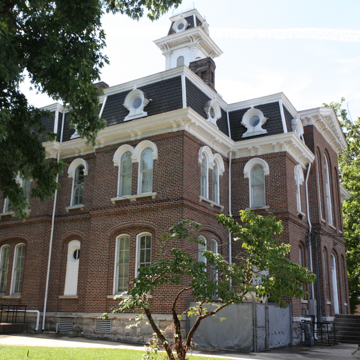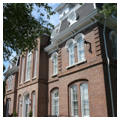Constructed between 1877 and 1879 in the center of the courthouse square at Carthage, the Smith County Courthouse is one of the finest examples of the Second Empire style in Tennessee. The distinctive building retains original character-defining architectural elements such as a slate-covered mansard roof, a central cupola clock tower, arched windows, and porthole dormers.
Carthage, overlooking the Cumberland River, was founded as the seat of Smith County in 1804. In the antebellum era, the town was an important inland river port for shipping timber, livestock, and tobacco to Nashville. During the Reconstruction Era, this ornate two-story courthouse was erected on a 300-foot civic square, one that is, today, peppered with historic markers, monuments, and mature trees framing the main entrance. This building replaced the original brick courthouse built in 1805 at the same site. The grandiose scale of the new courthouse was especially noteworthy since the town’s population was only around 475 people at the time of construction.
Though the architect for the courthouse is uncertain, historians have attributed the design to its builders, Edmund P. Turner (1825–1892) and Henry C. Jackson. Indeed, county records in Carthage state that an “E.P. Turner” provided the plans and specifications in January 1876. But Turner was a carpenter and joiner specializing in the construction of staircases, not an architect. The building’s Second Empire sophistication suggests that Turner’s business partner, William R. Gunn (1845–1910), likely designed the courthouse. A native of Canada, Gunn arrived in Nashville before 1872; by 1876 he had partnered with carpenter Turner. Where Gunn received his architectural training is unknown, but between 1875 and 1907 he designed some 100 theaters and opera houses throughout the U.S., including buildings in Macon, Savannah, and Hawkinsville, Georgia; Monticello, Florida; and Chicago, Illinois. In Nashville in 1875, Gunn was responsible for a major renovation of the antebellum Adelphi Theater and for designing the Sulphur Dell Ballpark in 1884. By 1896, Gunn had relocated to Atlanta, Georgia, where he died in 1910.
When completed in 1879, the Smith County Courthouse included county offices on the first floor and a courtroom on the second floor. Constructed of brick with a hewn limestone foundation, the symmetrical building exhibits typical Second Empire architectural elements such as a two-tiered central cupola clock tower topped by original iron cresting, straight-edge mansard roofs covered with slate, arched windows with heavily molded hoods, deep eaves with bracketed cornices, porthole dormers, and brick quoins. Projecting entrance pavilions are located in the center of the five-bay elevations at both the front and rear. The courthouse also possesses paired interior brick chimneys, four-over-four wood sash windows, a hewn limestone water table, and protruding brick belt courses. In the mid-twentieth century, metal and glass doors surmounted by a segmental arched fanlight replaced the original wooden doors of the main entrance.
The Smith County Courthouse has never been enlarged nor has the exterior been significantly altered, with the exception of the reconfiguration of the main entrance and the replacement of the original purple and green Vermont slate roof with the current gray slate. When additional space was needed in the mid-1960s, instead of adding new wings, the county constructed small detached offices and a public library at the rear. Most of the original black walnut and pine interior woodwork was removed during a renovation in the 1970s. Today, the courthouse is used as a theater and as a gathering place for civic groups and many in the community have expressed an interest removing the interior’s non-historic features at some point in the future.
Despite a modest population of only 2,200, Carthage has been home to several nationally significant political statesmen. Cordell Hull (1871–1955) practiced law in the courthouse for many years before Franklin Roosevelt appointed him U.S. Secretary of State in 1933. Former U.S. Senator and Vice President Al Gore (b. 1948) and his father, U.S. Senator Albert Gore Sr. (1907–1998), are also from Carthage. The younger Gore announced every one of his political campaigns between 1976 and 2000—including his 1992 vice-presidential bid with running mate Governor Bill Clinton—from the steps of the Smith County Courthouse.
References
Carpenter, John W., and Michael Emrick. Tennessee Courthouses: A Celebration of 200 Years of County Courthouses. London, KY: John W. Carpenter, 1996.
Church, Barbara Hume, and Robert E. Dalton, “Smith County Courthouse,” Smith County, Tennessee. National Register of Historic Places Inventory–Nomination Form, 1979. National Park Service, U.S. Department of the Interior, Washington, D.C.
Funderberg, Lise. “14 Historic American Theaters,” Architectural Digest, January 2015.
Herndon, Joseph L. “Architect in Tennessee until 1930.” Master’s rhesis, Columbia University, 1975.
Maggart, Sue W. “Smith County.” Tennessee Encyclopedia of History and Culture. Version 2.0, Online Edition. Nashville: Tennessee Historical Society, 2000–2018. http://tennesseeencyclopedia.net/.
Patrick, James. Architecture in Tennessee, 1767-1897. Knoxville: University of Tennessee Press, 1981.








